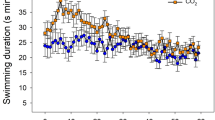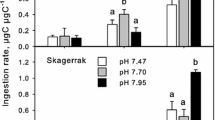Abstract
Ocean acidification can impair an animal’s physiological performance and energetically demanding activities such as swimming. Behavioural abnormalities and changed activity in response to ocean acidification are reported in fish and crustacean species. We studied swimming activity in the calanoid copepod Pseudocalanus acuspes in response to near-future ocean acidification. Water and copepods were sampled from ten mesocosms deployed on the Swedish west coast. The experiments were conducted on animals reared in the mesocosms for 2 months during spring. Copepods were filmed after long-term (chronic) high-CO2, and after 20 h acute exposure to CO2. There was no significant effect of CO2 on copepods in chronic high-CO2, nor significant effect after the 20 h acute exposure. In addition, we measured prosome length from a large number of adult copepods, but no effect of acidification on body size was found. In this study, P. acuspes did not show sensitivity to near-future pCO2 levels. Even if a number of papers suggest that copepods seem robust to future ocean acidification, interaction between multiple stress factors, such as elevated temperature, hypoxia and salinity changes may impair a copepod’s ability to resist lowered pH.


Similar content being viewed by others
References
Almén, A.-K., A. Vehmaa, A. Brutemark & J. Engström-Öst, 2014. Coping with climate change? Copepods experience drastic variations in their physicochemical environment on a diurnal basis. Journal of Experimental Marine Biology and Ecology 460: 120–128.
Almén, A.-K., A. Vehmaa, A. Brutemark, L. Bach, S. Lischka, A. Stuhr, et al., 2016. Negligible effects of ocean acidification on Eurytemora affinis (Copepoda) offspring production. Biogeosciences 13: 1037–1048.
Bach, L. T., J. Taucher, T. Boxhammer, A. Ludwig, The Kristineberg KOSMOS Consortium, E. P. Achterberg, et al., 2016. Influence of ocean acidification on a natural winter-to-summer plankton succession: first insights from a long-term mesocosm study draw attention to periods of low nutrient concentrations. PLoS ONE 11(8): e0159068.
Bradley, C. J., J. R. Strickler, E. J. Buskey & P. H. Lenz, 2013. Swimming and escape behavior in two species of calanoid copepods from nauplius to adult. Journal of Plankton Research 35: 49–65.
Briffa, M., K. de la Haye & P. L. Munday, 2012. High CO2 and marine animal behaviour: potential mechanisms and ecological consequences. Marine Pollution Bulletin 64: 1519–1528.
Caldeira, K. & M. E. Wickett, 2003. Anthropogenic carbon and ocean pH. Nature. 425: 365.
Cailleaud, K., F. G. Michalec, J. Forget-Leray, H. Budzinski, J. S. Hwang, et al., 2011. Changes in the swimming behavior of Eurytemora affinis (Copepoda, Calanoida) in response to a sub-lethal exposure to nonyphenols. Aquatic Toxicology 102: 228–231.
Corkett, C. J. & I. A. MacLaren, 1978. The biology of Pseudocalanus. Advances in Marine Biology 15: 1–238.
Cripps, G., P. Lindeque & K. J. Flynn, 2014a. Have we been underestimating the effects of ocean acidification in zooplankton? Global Change Biology 20: 3377–3385.
Cripps, G., P. Lindeque & K. J. Flynn, 2014b. Parental exposure to elevated pCO2 influences the reproductive success of copepods. Journal of Plankton Research 36: 1165–1174.
Cripps, I. L., P. L. Munday & M. I. McCormick, 2011. Ocean acidification affects prey detection by a predatory reef fish. PLoS ONE 6: e22736.
de la Haye, K. L., J. I. Spicer, S. Widdicombe & M. Briffa, 2012. Reduced pH sea water disrupts chemo-responsive behavior in an intertidal crustacean. Journal of Experimental Marine Biology and Ecology 412: 134–140.
De Wit, P., S. Dupont & P. Thor, 2016. Selection on oxidative phosphorylation and ribosomal structure as a multigenerational response to ocean acidification in the common copepod Pseudocalanus acuspes. Evolutionary Applications 9: 1112–1123.
Dissanayake, A. & A. Ishimatsu, 2011. Synergistic effects of elevated CO2 and temperature on the metabolic scope and activity in a shallow-water coastal decapod (Metapenaeus joyneri; Crustacea: Penaeidae). ICES Journal of Marine Science 68: 1147–1154.
Dorey, N., P. Lancon, M. Thorndyke & S. Dupont, 2013. Assessing physiological tipping point of sea urchin larvae exposed to a broad range of pH. Global Change Biology 19: 3355–3367.
Dudel, J., A. Gryder, S. Kaji, W. Kuffler & D. D. Potter, 1961. Gamma-aminobutyric acid and other blocking compounds in crustacea. I. Central nervous system. Journal of Neurophysiology 26: 739–751.
Dur, G., S. Soussi, F. Schmitt, F.-G. Michalec, M.-S. Mahjoub & S.-S. Hwang, 2011. Effects of animal density, volume, and the use of 2D/3D recording on behavioural studies of copepods. Hydrobiologia 666: 197–214.
Engström-Öst, J., T. Holmborn, A. Brutemark, H. Hogfors, A. Vehmaa & E. Gorokhova, 2014. The effects of short-term pH decrease on the reproductive output of the copepod Acartia bifilosa – a laboratory study. Marine and Freshwater Behavior and Physiology 47: 173–183.
Fabry, V. J., B. A. Seibel, R. A. Feely & J. C. Orr, 2008. Impacts of ocean acidification on marine fauna and ecosystem processes. ICES Journal of Marine Science 65: 414–432.
Fitzer, S. C., G. S. Caldwell, A. J. Close, A. S. Clare, R. C. Upstill-Goddard & M. G. Bentley, 2012. Ocean acidification induces multi-generational decline in copepod naupliar production with possible conflict for reproductive resource allocation. Journal of Experimental Marine Biology and Ecology 418–419: 30–36.
Green, L. & F. Jutfelt, 2014. Elevated carbon dioxide alters the plasma composition and behaviour of a shark. Biology Letters 10: 20140538.
Hamilton, T. J., A. Holcombe & M. Tresguerres, 2014. CO2-induced ocean acidification increases anxiety in Rockfish via alteration of GABAA receptor functioning. Proceedings of the Royal Society B 281: 20132509.
Hays, G. C., 2003. A review of the adaptive significance and ecosystem consequences of zooplankton diel vertical migrations. Hydrobiologia 503: 163–170.
Heuschele, J. & T. Kiørboe, 2012. The smell of virgins: mating status of females affects male swimming behaviour in Oithona davisae. Journal of Plankton Research 34: 929–935.
IPCC, 2013. Climate change: The physical science basis. Contribution of Working Group I to the Fifth Assessment Report of the Intergovernmental Panel on Climate Change. Cambridge University Press, Cambridge, United Kingdom and New York, NY, USA.
Jutfelt, F. & M. Hedgärde, 2013. Atlantic cod actively avoid CO2 and predator odour, even after long-term CO2 exposure. Frontiers in Zoology 10: 81.
Jutfelt, F., K. Bresolin de Souza, A. Vuylsteke & J. Sturve, 2013. Behavioural disturbances in a temperate fish exposed to sustained high-CO2 levels. PLoS ONE 8: e65825.
Kiørboe, T., 2011. What makes pelagic copepods so successful? Journal of Plankton Research 33: 677–685.
Klein Breteler, W. C. M., S. R. Gonzalez & N. Schogt, 1995. Development of Pseudocalanus elongatus (Copepoda, Calanoida) cultured at different temperature and food conditions. Marine Ecology Progress Series 119: 99–110.
Kroeker, K. J., R. L. Kordas, R. Crim, I. E. Hendriks, L. Ramajo, G. S. Singh, C. M. Duarte & J.-P. Gattuso, 2013. Impacts of ocean acidification on marine organisms: quantifying sensitivities and interaction with warming. Global Change Biology 19: 1884–1896.
Li, W. & K. Gao, 2012. A marine secondary producer respires and feeds more in a high CO2 ocean. Marine Pollution Bulletin 64: 699–703.
Ma, X. & K. B. Johnson, 2017. Comparative phototaxis of calanoid and harpacticoid copepods. Marine Biology 164: 26.
Maneja, R. H., A. Y. Frommel, H. I. Browman, C. Clemmesen, A. J. Geffen, A. Folkvord, et al., 2012. The swimming kinematics of larval Atlantic cod, Gadus morhua L., are resilient to elevated seawater pCO2. Marine Biology 160: 1963–1972.
McConville, K., C. Halsband, E. S. Fileman, P. J. Somerfield, H. S. Findlay & J. I. Spicer, 2013. Effects of elevated CO2 on the reproduction of two calanoid copepods. Marine Pollution Bulletin 73: 428–434.
Munday, P. L., A. J. Cheal, D. L. Dixson, J. L. Rummer & K. E. Fabricius, 2014. Behavioural impairment in reef fishes caused by ocean acidification at CO2 seeps. Nature Climate Change 4: 487–492.
Nilsson, G. E., D. L. Dixson, P. Domenici, M. I. McCormick, C. Sørensen, S.-A. Watson, et al., 2012. Near-future carbon dioxide levels alter fish behaviour by interfering with neurotransmitter function. Nature Climate Change 2: 201–204.
Norrbin, M. F., 1991. Gonad maturation as an indication of seasonal cycles for several species of small copepods in the Barents Sea. Polar Research 10: 421–432.
Pedersen, S. A., O. J. Håkedal, I. Salaberria, A. Tagliati, L. M. Gustavson, B. M. Jenssen, A. J. Olsen & D. Altin, 2014. Multigenerational exposure to ocean acidification during food Limitation reveals consequences for copepod scope for growth and vital rates. Environmental Science & Technology 48: 12275–12284
Pörtner, H. O., M. Langenbuch & B. Michaelidis, 2005. Synergistic effects of temperature extremes, hyposxia, and increases in CO2 on marine animals: From Earth history to global change. Journal of Geophysical Research 110:C09S10. doi:10.1029/2004JC002561
R Development Core Team, 2012. R: a language and environment for statistical computing. R Foundation for Statistical Computing, Vienna, Austria [available on internet at https://www.r-project.org/].
Rihel, J., D. A. Prober, A. Arvanites, K. Lam, S. Zimmermann, S. Jang, et al., 2010. Zebrafish behavioral profiling links drugs to biological targets and rest/wake regulation. Science 327: 348–351.
Seuront, L., 2013. Chemical and hydromechanical components of mate-seeking behaviour in the calanoid copepod Eurytemora affinis. Journal of Plankton Research 35: 724–743.
Sundin, J. & F. Jutfelt, 2016. 9–28 d of exposure to elevated pCO2 reduces avoidance of predator odour but had no effect on behavioural lateralization or swimming activity in a temperate wrasse (Ctenolabrus rupestris). ICES Journal of Marine Science 73: 620–632.
Svansson, A., 1984. Hydrography of the Gullmar Fjord. Meddelande från Havsfiskelaboratoriet Lysekil. nr 297, Institute of Hydrographic Research, Göteborg, series no 23.
Thor, P. & S. Dupont, 2015. Transgenerational effects alleviate severe fecundity loss during ocean acidification in a ubiquitous planktonic copepod. Global Change Biology 21: 2261–2271.
Tiselius, P., 1992. Behavior of Acartia tonsa in patchy food environments. Limnology and Oceanography 37: 1640–1651.
Titelman, J. & P. Tiselius, 1998. Vertical distribution, grazing and egg production of calanoid copepods during winter-spring in Gullmarsfjorden. Hydrobiologia 375(376): 343–351.
Uttieri, M., G.-A. Paffenhöfer & M. G. Mazzocchi, 2008. Prey capture in Clausocalanus furcatus (Copepoda: Calanoida). The role of swimming behaviour. Marine Biology 153: 925–935.
Vehmaa, A., A. Brutemark & J. Engström-Öst, 2012. Maternal effects may act as an adaptation mechanism for copepods facing pH and temperature changes. PLoS ONE 7: e48538.
Vehmaa, A., A.-K. Almén, A. Brutemark, A. Paul, U. Riebesell, S. Furuhagen & J. Engström-Öst, 2016. Ocean acidification challenges copepod phenotypic plasticity. Biogeosciences. doi:10.5194/bg-13-6171-2016.
Vehmaa, A., H. Hogfors, E. Gorokhova, A. Brutemark, T. Holmborn & J. Engström-Öst, 2013. Projected marine climate change: effects on copepod oxidative status and reproduction. Ecology and Evolution 13: 4548–4557.
Watson, S.-A., S. Lefevre, M. I. McCormick, P. Domenici, G. E. Nilsson & P. E. Munday, 2014. Marine mollusc predator-escape behaviour altered by near-future carbon dioxide levels. Proceedings of the Royal Society B 281: 20132377.
Weydmann, A., J. E. Søreide, S. Kwasniewski & S. Widdicombe, 2012. Influence of CO2-induced acidification on the reproduction of a key Arctic copepod Calanus glacialis. Journal of Experimental Marine Biology and Ecology 428: 39–42.
Whiteley, N. M., 2011. Physiological and ecological responses of crustaceans to ocean acidification. Marine Ecology Progress Series 430: 257–271.
Zervoudaki, S., E. Krasakopouloub, T. Moutsopoulosa, M. Protopapac, S. Marrod & F. Gazeaud, 2017. Copepod response to ocean acidification in a low nutrient-low chlorophyll environment in the NW Mediterranean Sea. Estuarine, Coastal and Shelf Science 186: 152–162.
Acknowledgements
We thank the entire KOSMOS team from GEOMAR, Kiel for providing the opportunity to participate in the mesocosm project. Great thanks to Andrea Ludwig for organizing logistics. We thank Maria Alguero, Henriette Horn and Julia Lange for the joint sampling effort during our stay and the Sven Lovén Centre for Marine Sciences Kristineberg for providing excellent working facilities. We also thank Andreas Lindén for valuable input on the statistical models and Lara Valentič for great company during the trip and help in the lab. The study was supported by the Academy of Finland (Project No. 276947), Victoriastiftelsen and Walter och Andrée de Nottbecks stiftelse.
Author information
Authors and Affiliations
Corresponding author
Additional information
Handling editor: Iacopo Bertocci
Rights and permissions
About this article
Cite this article
Almén, AK., Brutemark, A., Jutfelt, F. et al. Ocean acidification causes no detectable effect on swimming activity and body size in a common copepod. Hydrobiologia 802, 235–243 (2017). https://doi.org/10.1007/s10750-017-3273-5
Received:
Revised:
Accepted:
Published:
Issue Date:
DOI: https://doi.org/10.1007/s10750-017-3273-5




